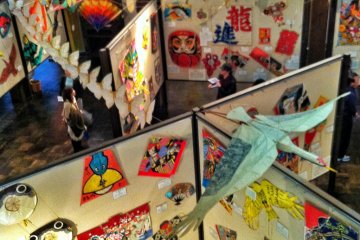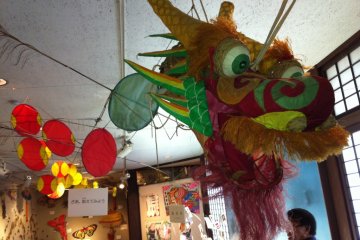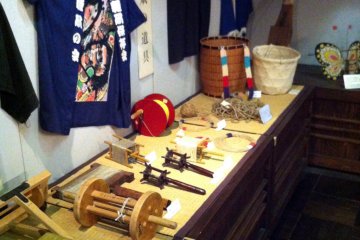Ikazaki is a spectacular place. Birds of prey—kites in fact—turn lazy circles a thousand feet up in the air between the mountain peaks, and colorful hang gliders are often seen in the sky along with the birds. There’s something about this broad, flat river valley with its widely spaced mountains and big sky that tempts ground dwellers to take wing and fly.
But this isn’t such an easy thing to do. A good alternative however is to fly a kite, the bigger the better. And this is what they do in Ikazaki. Every year on Children’s Day (May 5th) when the weather is getting warmer, the people of the town attempt to fly a giant kite called the shusse kite, which represents success in life. Parents of children who were born that year write their children’s names on it, and the symbolism is pretty obvious. Apparently this custom started in the Kamakura era in the 14th century. Another custom that appeared later in the Edo period is kite fighting, where a metal blade is attached to the string of each kite. The aim is to cut the string of other people’s kites. Considering how difficult it can be get a kite up in the air in the first place, this seems like a grotesquely spiteful thing to do.
If you can’t make it to the kite-flying event, you can still visit the Ikazaki Kite Museum, which is a very rewarding experience in itself. They have hundreds of different kites from all over the world, attractively displayed on the walls and suspended from the ceiling. The first section is devoted to kites from other countries, then there’s a large hall displaying kites from all over Japan. The sheer variety of shapes and designs is quite amazing, and a visit to this museum is a treat for anyone with an interest in design, or arts and crafts. Many of the kites are humorous—one of my favorites was a face with a big red tongue that hangs down, and eyeballs of silver paper that spin in the wind.
As if that isn’t enough, the entry fee of ¥300 also includes loan of a kite. You can take your kite out onto the riverbank and run up and down until you have it fluttering in the air above the river, a hundred feet up. When I was done with my kite, there were several stubborn knots in the string and I was quite ashamed to be handing it back in that condition. But the museum staff were very gracious about it. They’ve obviously seen that sort of thing before. They didn’t even seem alarmed when I declared, “I’ll be back!”










